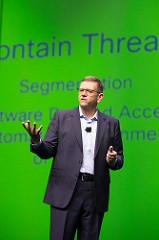DALLAS – Two months ago Cisco introduce its Network Intuitive strategy and product line. But that announcement did not come with a strategy for channel partners until now.
At the 2017 Cisco Partner Summit, David Goeckeler, the executive vice president & GM of Cisco’s networking and security business, outlined what the channel profitability plan may look like.
Cisco is looking to address its traditional strength in markets such as commercial, enterprise and service provider, but Goeckeler also include SMB along with a new area called Web Scale.
“Web Scale has a new set of economics with disaggregation, scalability and operational efficiency. The whole concept is on automation and this is sweeping the market and there is talk that this is the future of networking; as a DIY project,” he said.
Goeckeler suggested to the more than 2,200 channel partner companies in attendance at the conference, to look deeper than that towards the SMB and commercial saying the same type of automated solutions can be there too. Meraki is being positioned in those two sectors and Goeckeler added that the value proposition should be different than in the enterprise or service provider area and be based on simplicity.

“People don’t need to have all the software skills for building a network; they just want a network. This is where the Network Intuitive begins,” he said. “Think of self-driving cars. This is the type of automation there can be for networks.”
The strategy behind the new profitability path with Intent-based networks starts with the concept that customers want a lower point of scale. “CIOs are saying technical staff need large-hands because of all the manual processes with thousands of devices. This is not an automated architecture. This is what we are changing. This is why we have breaches,” Goeckeler said.
With that Cisco has released new metrics for profitability for Intent-based networking. Goeckeler said, these new metrics will educate channel partners on if they are providing a real intuitive network for the customer.
The metrics are:
- Time to deploy policy changes – needs to go from hours down to minutes.
- Time to detect network issues – needs to go from weeks down to minutes.
- Time to update the infrastructure – needs to go from weeks down to hours.
- And, time to detect malware must go from months down to hours.
The other major market opportunity is in security.
According to Goeckeler, the market shows that many customers have been building a security posture without leveraging the network. “People will say this is very convenient for me to say. Maybe it is, but that does not mean it’s not true. You cannot keep everyone out of your network. People doing break ins are not breaking in but logging in with credentials.”
The strategy of a perimeter defense is action that may have worked best 10 years ago.
There are three things channel partners should be doing in this area, Goeckeler suggested.
- Segmentation, where intruders are unable to move laterally and are confined to a small space. Segmentation is an area that should be automated. With this you can identify the intruders through visibility technics.
- Automate remediation, Cisco is pushing partners to automate the response and have a network that can adapt. For example, if an end point is compromised it can be moved automatically to an area where they can only surf the web.
- Applying analytics, it is Cisco strategy to drive across both visibility and analytics on an automated network for better security. Apply analytics can enable the partner or customer to achieve a better response.
“The largest tech market in the world today is simplicity. It is being applied to every domain. You don’t type it in anymore; you talk to something. This is happening in the device market and we need to do this in the networking space,” Goeckeler said.
The next path to profitability is to take the platform and make it infinitely vertical and specific to a particular business.
This will also involve Cisco’s new DNA Center solution for managing policy, automation and analytics being connected to Intent-based networking infrastructure. This will help the customer gain better security, intent and context. Goeckeler said that the number of customers with all three is less than 20 per cent. “This is a great cross sell motion for channel partners once we have DNA Center deployed and the cost for wireless goes down. This is a new motion for going to market for the channel,” he said.
The next step after that is Intent-based infrastructure with the Cisco ONE Advantage with Catalyst 9K. Goeckeler believes this is a brownfield opportunity for the channel that could involve upgrades with DNA licenses and partners can sell more Catalyst switches.
“This is a whole new infrastructure play,” he said.
The final step is with analytics. This is being addressed later on with the release of a new Network Data Platform (NDP) from Cisco that will tie into the new DNA Center.
“The most important thing is to get started. This is a journey because most people don’t get up in the morning and decide they want to change the network. It starts with Identity Services Engine (ISE) and Stealthwatch,” Goeckeler said.
